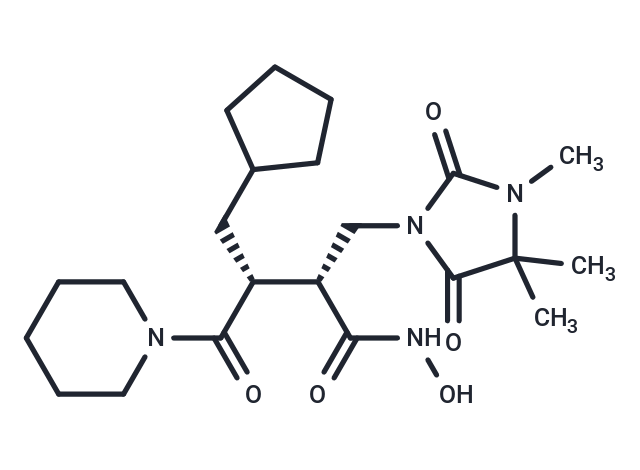Shopping Cart
- Remove All
 Your shopping cart is currently empty
Your shopping cart is currently empty

Cipemastat is a competitive inhibitor of human collagenases 1, 2, and 3 (Kis: 3.0, 4.4, and 3.4 nM).

| Pack Size | Price | Availability | Quantity |
|---|---|---|---|
| 25 mg | $1,390 | 8-10 weeks | |
| 50 mg | $1,810 | 8-10 weeks | |
| 100 mg | $2,750 | 8-10 weeks |
| Description | Cipemastat is a competitive inhibitor of human collagenases 1, 2, and 3 (Kis: 3.0, 4.4, and 3.4 nM). |
| Targets&IC50 | Gelatinase B:59.1 nM (ki), Gelatinase A:154 nM (ki), Collagenases 3:3.4 nM (ki), Collagenases 2:4.4 nM (ki), MMP3:527 nM (ki), Collagenases 1:3.0 nM (ki) |
| In vitro | Cipemastat (Ro 32-3555) is a potent inhibitor of rat collagenase (IC50: 44.7 nM) and inhibits IL-1a-induced cartilage degradation in vitro in a concentration-dependent manner (IC50: 60 nM), without cytotoxic effects on explant chondrocytes, and does not alter glucose utilization when compared to IL-1a alone. |
| In vivo | In non-implanted cartilage, the hydroxyproline concentration is 119.3 nM/mg, which decreases to 53.6 nM/mg over fourteen days in vehicle-dosed animals. Oral administration of Cipemastat at 2.5, 5, 10, and 25 mg/kg significantly increases the hydroxyproline levels in implanted cartilage. Fourteen days post-second P. acnes challenge injection, the lateral femoral condyle was the primary area analyzed. Arthritic animals showed a significant decrease in mean cartilage area to 0.086±0.01 mm^2 (n=10), compared to 0.17±0.02 mm^2 (n=5) in non-arthritic animals. Cipemastat-treated animals (50 mg/kg, p.o.) demonstrated a significantly greater mean cartilage area of 0.126±0.012 mm^2 (n=9). The pannus area was 0.099±0.017 mm^2 in vehicle-dosed and 0.102 mm^2 in Cipemastat-dosed animals. Vehicle-dosed rats with adjuvant-induced arthritis showed two phases of paw swelling: primary (1.9±0.1 mL, days 0-5) and secondary (0.98±0.08 mL, days 9-14). Dexamethasone (0.1 mg/kg) significantly reduced both primary (0.2±0.03 mL) and secondary (0.07±0.08 mL) swelling and completely inhibited lesion scoring. |
| Alias | Ro 32-3555 |
| Molecular Weight | 436.55 |
| Formula | C22H36N4O5 |
| Cas No. | 190648-49-8 |
| Relative Density. | 1.205 g/cm3 (Predicted) |
| Storage | Powder: -20°C for 3 years | In solvent: -80°C for 1 year | Shipping with blue ice. |

Copyright © 2015-2025 TargetMol Chemicals Inc. All Rights Reserved.